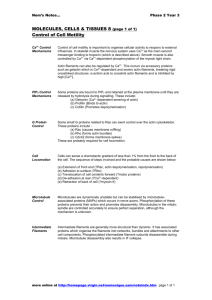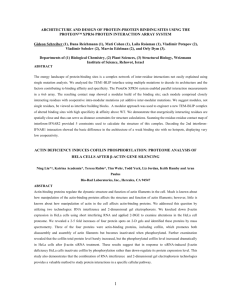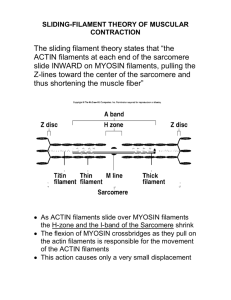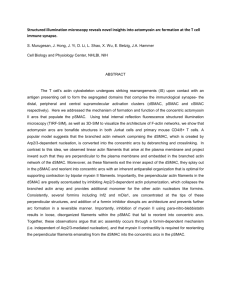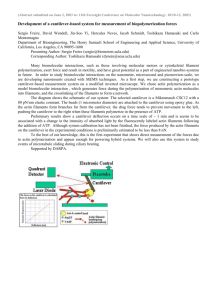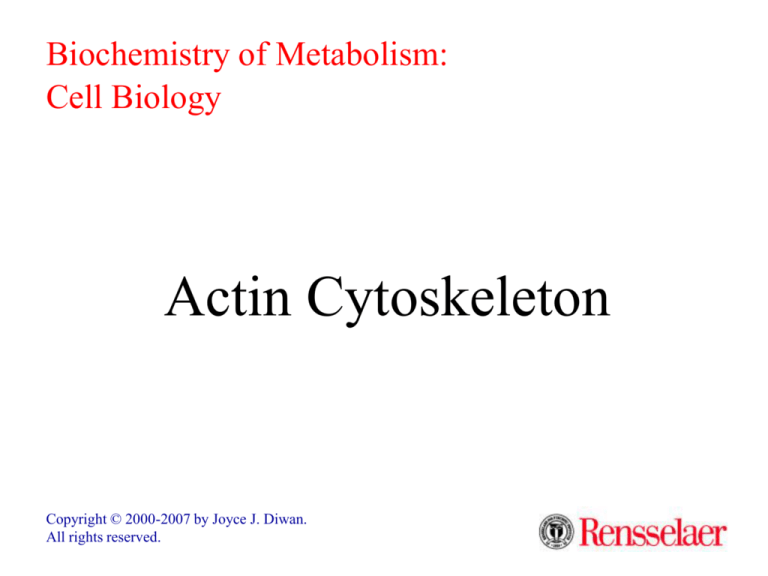
Biochemistry of Metabolism:
Cell Biology
Actin Cytoskeleton
Copyright © 2000-2007 by Joyce J. Diwan.
All rights reserved.
ATP
4
ATP
3
PDB 2BTF
2
1
G-actin
PDB 2BTF
G-actin
Actin monomer, depicted above in two
display modes, has subdomains 1-4.
A simplified cartoon is at right.
ATP binds, along with Mg++, within a
deep cleft between subdomains 2 & 4.
Actin monomer
with bound ATP
ATP
PDB 2BTF
G-actin
Actin can hydrolyze its bound ATP ADP + Pi,
releasing Pi.
The actin monomer can exchange bound ADP for ATP.
The conformation of actin is different, depending on
whether ATP or ADP is in the nucleotide-binding site.
G-actin (globular actin), with
bound ATP, can polymerize to
form F-actin (filamentous).
F-actin may hydrolyze bound
ATP ADP + Pi & release Pi.
ADP release from the filament
does not occur because the
cleft opening is blocked.
ADP/ATP exchange: G-actin
can release ADP & bind ATP,
which is usually present at
higher concentration than ADP
in the cytosol.
G-actin-ATP
polymerization
F-actin-ATP
Pi
F-actin-ADP
depolymerization
G-actin-ADP
ADP/ATP exchange
G-actin-ATP
actin-ADP
Actin filaments have polarity.
The actin monomers all orient with
their cleft toward the same end of
the filament, called the minus end.
The diagram above is oversimplified.
actin-ATP
+
Actin monomers spiral around the axis of the filament,
with a structure resembling a double helix.
See diagram in Biomachina website
myosin heads
actin filament
The polarity of actin filaments may be visualized by
decoration with globular heads (S1) cleaved off of
myosin by proteases.
Bound myosin heads cause an appearance of
arrowheads in electron micrographs.
See images in website of the Heuser Lab.
myosin heads
actin filament
In one experiment, short actin filaments were decorated
with myosin heads.
After removal of excess unbound myosin, the
concentration of G-actin was increased, to promote
further actin polymerization.
Filament growth at one end, designated plus (+),
exceeded growth at the other end, designated minus ().
In electron micrographs, bound myosin heads appear as
arrowheads pointing toward the negative end of the
filament. Barbed ends orient toward the plus end.
Actin treadmilling
Actin filaments may undergo treadmilling, in which
filament length remains approximately constant, while
actin monomers add at the (+) end and dissociate from
the () end.
This has been monitored using brief exposure to
labeled actin monomers (pulse labeling).
capping
protein
actin filament
Capping proteins bind at the ends of actin filaments.
Different capping proteins may either stabilize an actin
filament or promote disassembly.
They may have a role in determining filament length.
Examples:
Tropomodulins cap the minus end, preventing
dissociation of actin monomers.
CapZ capping protein binds to the plus end,
inhibiting polymerization.
If actin monomers continue to dissociate from the
minus end, the actin filament will shrink.
Two toxins that have been useful experimentally:
Cytochalasins (from fungi) bind to the (+) end of
F-actin and block subunit addition. Depolymerization
at the () end may cause loss of the filament.
Phalloidin (from Amanita mushroom) binds along
the sides of actin filaments, stabilizing them.
Phalloidin labeled with a fluorescent chromophore
is often used to visualize actin filaments by
fluorescence microscopy.
Cross-linking proteins organize actin
filaments into bundles or networks.
Actin-binding domains of several
cross-linking proteins (e.g., filamin,
a-actinin, spectrin, dystrophin &
fimbrin) are homologous.
Most cross-linking proteins are dimeric
or have 2 actin-binding domains.
a-Actinin binds
actin into parallel
filament bundles.
Some actin-binding proteins such as a-actinin, villin &
fimbrin bind actin filaments into parallel bundles.
Depending on the length of a cross-linking protein, or the
distance between actin-binding domains, actin filaments in
parallel bundles may be held close, or may be far enough
apart to allow interaction with other proteins, e.g., myosin.
Filamins dimerize, through
antiparallel association of their
C-terminal domains, to form
V-shaped cross-linking proteins
that have a flexible shape due to
hinge regions.
Filamin cross-links
actin in loose networks.
Filamins organize actin filaments into loose networks
that give some areas of the cytosol a gel-like consistency.
Filamins may also have scaffolding roles relating to their
ability to bind constituents of signal pathways such as
plasma membrane receptors, calmodulin, caveolin, protein
kinase C, transcription factors, etc.
Spectrin is an actin-binding protein that forms an
elongated tetrameric complex having an actin-binding
domain at each end.
With short actin filaments, spectrin forms a cytoskeletal
network on the cytosolic surface of the plasma
membrane of erythrocytes and some other cells.
For a diagram see a website of L. Backman.
Cell structures that involve actin:
Filopodia (microspikes) are long, thin and transient
processes that extend out from the cell surface.
Bundles of parallel actin filaments, with plus ends
oriented toward the filopodial tip, are cross-linked by a
small actin-binding protein such as fascin.
The closely spaced actin filaments provide stiffness.
Microvilli are shorter & more numerous protrusions
of the cell surface found in some cells.
Tightly bundled actin filaments within these structures
also have their plus ends oriented toward the tip.
Small cross-linking proteins such as fimbrin and villin
bind actin filaments together within microvilli.
Lamellipodia are thin but broad projections at the edge
of a mobile cell.
Lamellipodia are dynamic structures, constantly
changing shape.
See Movie on lamellipodial action in wound closure.
Lamellipodia, at least in some motile cells, have been
shown to contain extensively branched arrays of actin
filaments, oriented with their plus (barbed) ends toward
the plasma membrane.
Forward extension of a lamellipodium occurs by
growth of actin filaments adjacent to the plasma
membrane.
Stress fibers form when a cell makes stable connections
to a substrate.
• Bundles of actin filaments extend from the cell
surface through the cytosol.
The actin filaments, whose plus ends are oriented
toward the cell surface on opposite sides of the cell,
may overlap in more interior regions of a cell in
anti-parallel arrays.
• Myosin mediates sliding of anti-parallel actin
filaments during contraction of stress fibers.
• a-Actinin may cross-link actin filaments within
stress fibers.
Some cells have a cytoskeletal network just inside
the plasma membrane that includes actin along with
various other proteins such as spectrin.
This cytoskeleton has a role in maintaining cell shape.
An example is found in erythrocytes.
Actin filaments have an essential role in the
contractile ring responsible for cytokinesis at the end
of mitosis in animal cells.
Actin is found in the cell nucleus as well as in the
cytoplasm. Recent data indicate involvement of actin in
regulation of gene transcription.
Nucleation of actin
polymerization:
Arp2/3
+
actin-ADP
Arp2/3 nucleates actin
polymerization in
lamellipodia.
actin-ATP
Arp2/3 complex includes 2 actin-related proteins, Arp2 &
Arp3, plus 5 smaller proteins.
When activated by a nucleation promoting factor (NPF),
Arp2/3 complex binds to the side of an existing actin
filament and nucleates assembly of a new filament branch.
The resulting branch structure is Y-shaped.
In this oversimplified diagram, Arp2 & Arp3 are shown
forming the start of a new branch of double-helical F-actin.
At the leading edge of
a lamellipodium, plus
end capping proteins
may keep actin filaments
short, while Arp2/3
keeps initiating new
branches to propel the
edge of the cell forward.
Arp2/3
+
actin-ADP
actin-ATP
It has been argued that the network of short, branching
actin filaments seen in lamellipodia of some cell types
could be more effective in pushing the leading edge
forward than unbranched filaments, given the flexibility of
actin filaments.
Website with movies & micrographs.
Arp2/3
+
actin-ADP
actin-ATP
Further back from the leading edge, actin-destabilizing
proteins, e.g., cofilin & gelsolin (to be discussed), would
promote loss of actin monomers from the minus end.
The continuous plus-end filament growth at the leading
edge, and minus-end disassembly behind, show up as
treadmilling of labeled actin monomers.
See a movie (select Fig 10).
+
formin FH2
domain dimer
actin-ADP
actin-ATP
Formins nucleate formation of unbranched actin filaments,
such as those in stress fibers.
Formins are found at the plus ends of actin filaments.
Formin is said to be processive, because it remains bound
to the plus end of an actin filament as actin monomers are
added at the plus end.
The continued presence of formin prevents binding of
plus-end capping proteins that would inhibit filament
growth.
+
formin FH2
domain dimer
actin-ADP
actin-ATP
Each formin includes an actin-binding FH2 domain that
dimerizes to form a ring-like structure with flexible links.
Models have been proposed involving "stair stepping" by
the dimeric formin to explain its ability to remain at the
plus end as actin monomers are added.
E.g., it has been proposed that one FH2 domain of the
dimeric formin may shift to an "open" conformation
allowing entry of an actin monomer as the other FH2
domain binds to the most recently added actin subunit.
See a movie (Choose supplemental materials).
+
formin FH2
domain dimer
actin-ADP
actin-ATP
Other formin domains:
Another actin-binding domain (FH1) binds monomeric
actin complexed with profilin (to be discusssed).
This may increase the effective concentration of
monomeric actin adjacent to the polymerization site.
Regulatory domains of formins allow for autoinhibition
that is turned off during activation of actin
polymerization by the GTP-binding signal protein Rho
(to be discussed).
See a diagram (Fig. 1).
ligand-binding site
at a / b interface
Integrins: heterodimeric
cell surface receptors.
Each of the 2 integrin
subunits, designated a & b,
is a single-pass
transmembrane protein.
ab integrin
heterodimer
extracellular
space
cytosolic domains
bind cytoskeleton
Integrins mediate adhesion of cells to the extracellular
matrix as well as to other cells.
Cytosolic domains of integrins bind to adaptor proteins
(e.g., a-actinin, talin, filamin) that link integrins to
elements of the cytoskeleton such as actin filaments.
Extracellular ligands bind
at the a/b subunit interface.
Extracellular domains of
both a & b integrin subunits
contribute residues to the
ligand binding site.
There are multiple isoforms
of a & b subunits.
ligand-binding site
at a / b interface
ab integrin
heterodimer
extracellular
space
cytosolic domains
bind cytoskeleton
Different combinations of a & b subunits yield a variety
of integrins with different binding specificity. E.g.:
Extracellular domain of a1b1 integrin binds collagen.
Extracellular domain of a5b1 integrin binds fibronectin.
Integrins mediate dynamic connections between the
actin cytoskeleton inside a cell and constituents of the
extracellular matrix.
Moving cells make & break contacts with the matrix,
whereas stationary cells may form more stable
complexes with extracellular constituents.
Integrins have signaling as well as adhesive roles.
Outside-in signaling: Binding of ligands by
extracellular domains may generate conformational
changes that affect interaction of integrins with
intracellular cytoskeletal and signal proteins.
Inside-out signaling: The affinity of integrins for
extracellular ligands is subject to regulation by cell
signals.
The inactive integrin has a bent over conformation,
while in the fully activated state globular ligand binding
domains extend out maximally from the cell surface.
See diagrams in a website of the Walz lab at Harvard.
cytosol
actin
filament
cross-linker
adapter
complex
plasma
membrane
integrin
heterodimer
domain that binds
matrix proteins
Focal Adhesion
In focal adhesions stress fibers attach via adapter proteins
to plasma membrane integrins.
The adapter proteins that link actin filaments to cytosolic
domains of integrins include a-actinin & talin.
With extracellular domains of the integrins linked to matrix
proteins, a cell is firmly attached to the external matrix.
actin filaments
filamin or other cross-linker
cross-linked actin network (gel)
Ca++-activated gelsolin severs &
caps (+) end of actin filaments.
smaller filament fragments (sol)
Gelsolin functions in gel sol transitions in the cytosol.
When activated by Ca++, gelsolin, severs an actin filament
and caps the (+) end, blocking filament regrowth.
Actin filaments become kinked prior to being severed by
gelsolin.
Gelsolin may also function to promote forward
extension of a lamellipodium.
By severing actin filaments, gelsolin contributes to
the development of the branched actin filament
networks that grow to propel forward the plasma
membrane at the leading edge.
Gelsolin in the absence of Ca++ does not bind actin.
Ca++ causes a large conformational change in
gelsolin that exposes an actin-binding site.
Actin contributes a Glu carboxyl group to one of the
two Ca++-binding sites.
actin-gelsolin
G-actin shown
complexed with
the C-terminal
half of gelsolin,
with bound Ca++.
PDB 1DBO
Gelsolin, which
interacts also with
filamentous actin,
binds along the side of the actin monomer and in a cleft
between actin subdomains 1 & 3, at the plus end.
The hydrophobic cleft between actin subdomains 1 & 3 is
a common site of interaction with actin-binding proteins.
Subdomain 2 of actin itself binds to this cleft of the
adjacent monomer in F-actin.
Cofilin is a member of the
ADF (actin depolymerizing
factor) protein family.
Cofilin binds to actin-ADP
along the sides of actin
filaments, distorting the
helical twist.
actin-ADP
actin-ATP
+
cofilin
Under some conditions cofilin can sever actin filaments.
Cofilin also promotes dissociation of G-actin-ADP
(as a complex with cofilin) from minus ends of actin
filaments.
Cofilin may then bind to G-actin-ADP and inhibit
ADP/ATP exchange.
This would inhibit actin re-polymerization.
Phosphorylation of cofilin causes it to dissociate
from G-actin, which can then undergo ADP/ATP
exchange and add to the (+) end of F-actin.
Actin polymerization in some cases may be triggered
by signal cascades leading to phosphorylation of
cofilin.
Twinfilin is a protein structurally related to cofilin that
binds G-actin-ADP, and may have a role in sequestering
actin monomers.
Thymosin b4 is a small protein (5 kDa) that also forms
a 1:1 complex with G-actin.
Thymosin is proposed to “buffer” the concentration of
free actin, by maintaining a pool of monomeric actin.
An increase in the concentration of thymosin b4 may
promote depolymerization of F-actin, by lowering the
concentration of free G-actin.
Profilin has a role in
regulating actin
polymerization.
Profilin forms a 1:1
complex with G-actin.
Profilin binding at the
plus end, opposite the
nucleotide-binding cleft,
alters the conformation
of G-actin, making its
nucleotide-binding site
more open to the cytosol.
This promotes
ATP/ADP exchange.
ATP-Sr
actin
profilin
PDB file 2BTF
The stimulation by profilin of ATP/ADP
exchange increases the local
concentration of G-actin-ATP, the
form able to polymerize.
Actin
+
Profilin
Profilin may sequester actin monomers.
Localized release of G-actin-ATP by profilin may
promote actin polymerization.
Usually profilin promotes actin polymerization.
It may function as a carrier, donating the actin monomer
to the plus end of a filament.
Because profilin binds at the plus end of an actin
monomer, the actin monomer's minus end is available for
addition to the plus end of an existing actin filament.
O
O
R1
C
H2C
O
C
CH
H2C
Regulation of
assembly and
disassembly of the
actin cytoskeleton
is very complex.
O
cleavage by
Phospholipase C
R2
O
O
P
O
O
H
OPO32
OH
H
OH
PIP2
H
H
phosphatidylinositol4,5-bisphosphate
OH
H
H
OPO32
Derivatives of the membrane lipid phosphatidylinositol
are involved in signal cascades.
Signal-activated kinases convert phosphatidylinositol to
PIP2 (phosphatidylinositol-4,5-bisphosphate).
O
O
R1
C
H2C
O
O
C
CH
H2C
cleavage by
Phospholipase C
R2
O
O
P
O
O
H
OPO32
OH
H
OH
PIP2
H
H
phosphatidylinositol4,5-bisphosphate
OH
H
H
OPO32
Phospholipase C, activated by a signal cascade,
catalyzes cleavage of PIP2 to yield the signal molecules
diacylglycerol & inositol trisphosphate (IP3)
phosphatidyl inositol (in membrane)
In addition to its role
in generating the
second messengers
diacylglycerol and
IP3, PIP2 formation
and hydrolysis can
affect the actin
cytoskeleton.
PIP2
Phospholipase C
(signal activated)
IP3
causes Ca++
release from ER
diacylglycerol
activates
Protein Kinase C
E.g., regulated formation & cleavage of PIP2 can affect
the concentration of profilin, and hence actin
polymerization, adjacent to the plasma membrane.
PIP2 binds
profilin at the
cytosolic surface
of the plasma
membrane.
This prevents
profilin-actin
interaction.
Profilin release by PIP2 cleavage
plasma
membrane
DAG
PIP2
IP3
profilin
cytosol
actinprofilin
complex
Signal-activated PIP2 hydrolysis releases profilin, which
may bind G-actin and promote ADP/ATP exchange.
The increase in G-actin-ATP promotes actin
polymerization adjacent to the plasma membrane.
Some actin severing and capping proteins also
bind to PIP2, including gelsolin and cofilin.
Filament severing can be a mechanism for
increasing the number of plus ends to which
actin can polymerize.
Binding to PIP2 inhibits gelsolin and cofilin, and
sequesters them near the cell surface.
Their regulated release can affect formation of
lamellipodia or forward movement of a cell.
Nucleation promoting factors
that activate the Arp2/3
complex include proteins called
WASP & Scar (WAVE).
The genetic disease WiskottAldrich Syndrome gave WASP
its name.
Arp2/3
actin-ADP
actin-ATP
WASP/Scar proteins have domains that bind & activate
Arp2/3, plus domains that recognize & bind to signaling
factors that may be locally generated in a cell.
Thus WASP/Scar proteins may determine where in a
cell actin polymerization will occur.
Some WASP proteins are activated by binding to
proteins of the Rho family (see below) and/or to PIP2.
Some pathogens utilize a host cell's actin to move around
in an infected cell, & for transmission to other cells.
They move by growth of actin tails.
In Listeria, a bacterial cell-surface protein homologous
to WASP activates the Arp2/3 complex.
Shigella has a cell-surface protein that binds WASP.
Vaccinia virus has a surface protein that, when
phosphorylated, binds via adaptor proteins to WASP.
Salmonella encodes actin-binding proteins that
appear to directly nucleate actin filament growth.
Website with movies showing actin-based movement of Listeria
and Shigella within cells, maintained by J. Theriot at Stanford.
Rho is a family of small GTP-binding proteins that
regulate the actin cytoskeleton.
Some members of the Rho family:
Rac activates formation of lamellipodia, in part through
activation of WASP.
Cdc42 activates formation of filopodia, in part through
activation of the WASP family protein Scar (WAVE).
Rho activates formation of focal adhesions & stress
fibers, in part through activation of formins.
In each case the active form of the Rho family protein has
bound GTP.
Rho protein downregulation:
• GAPs (GTPase activating
proteins) facilitate GTP
hydrolysis by Rho.
• GDIs (Guanine nucleotide
dissociation inhibitors)
bind to Rho & prevent
GDP/GTP exchange.
Rho-GTP (active)
GDP
GEF
GTP
GAP
Pi
Rho-GDP (inactive)
Rho protein activation:
• GEFs (Guanine nucleotide exchange proteins) of the
Dbl family promote GDP release with binding of GTP.
• Dbl GEFs are activated by signal cascades initiated via
plasma membrane receptors, e.g., cytokine, growth
factor or cell adhesion receptors.
Rho-GTP
activates
ROCK phosphorylates to inhibit: Myosin Light Chain Phosphatase
phosphorylates
myosin light chains
(if not inhibited) dehosphorylates
myosin light chains
phosphorylation promotes myosin/actin interaction
stress fiber development & contraction
In addition to activating formins to promote actin filament
growth, Rho-GTP promotes myosin-actin interactions
essential for development & contraction of stress fibers,
through its activation of ROCK (Rho Kinase).
ROCK phosphorylates (& inhibits dephosphorylation of)
myosin II light chains. Light chain phosphorylation
promotes interaction of myosin with actin filaments.
Other Kinases that regulate formation or disassembly of
focal adhesions include:
Focal Adhesion Kinase (FAK) has a role in modulating
assembly of focal adhesions in response to tension
exerted by the cytoskeleton on attachments to the
extracellular substrate via integrins.
FAK acts through various downstream effectors,
including constituents of MAP Kinase signal pathways.
Integrin-Linked Kinase (ILK) binds to plasma
membrane integrins and to various actin-binding
proteins, thereby mediating attachment of actin to the
plasma membrane in focal adhesions.
ILK also phosphorylates & activates Protein Kinase B,
an enzyme with many regulatory roles.
Proteins of the ERM family (ezrin, radixin & moesin)
provide regulated linkage of actin filaments to the
plasma membrane in some cells.
ERM proteins bind to actin and bind to cytosolic
domains of plasma membrane integral proteins.
They are regulated by signal-activated phosphorylation
and by interaction with PIP2.
Calpains are Ca++-activated cysteine proteases that
regulate cell adhesion.
These intracellular proteases cleave constituents of stress
fibers & focal adhesions during activation of cell motility.
Proteins cleaved by calpains include:
actin-binding proteins such as a-actinin, filamin,
talin and spectrin
subunits of plasma membrane integrins
the ERM protein ezrin.
In addition to being activated by Ca++, calpains are
regulated by phosphorylation and are subject to inhibition
by a protein calpastatin.



